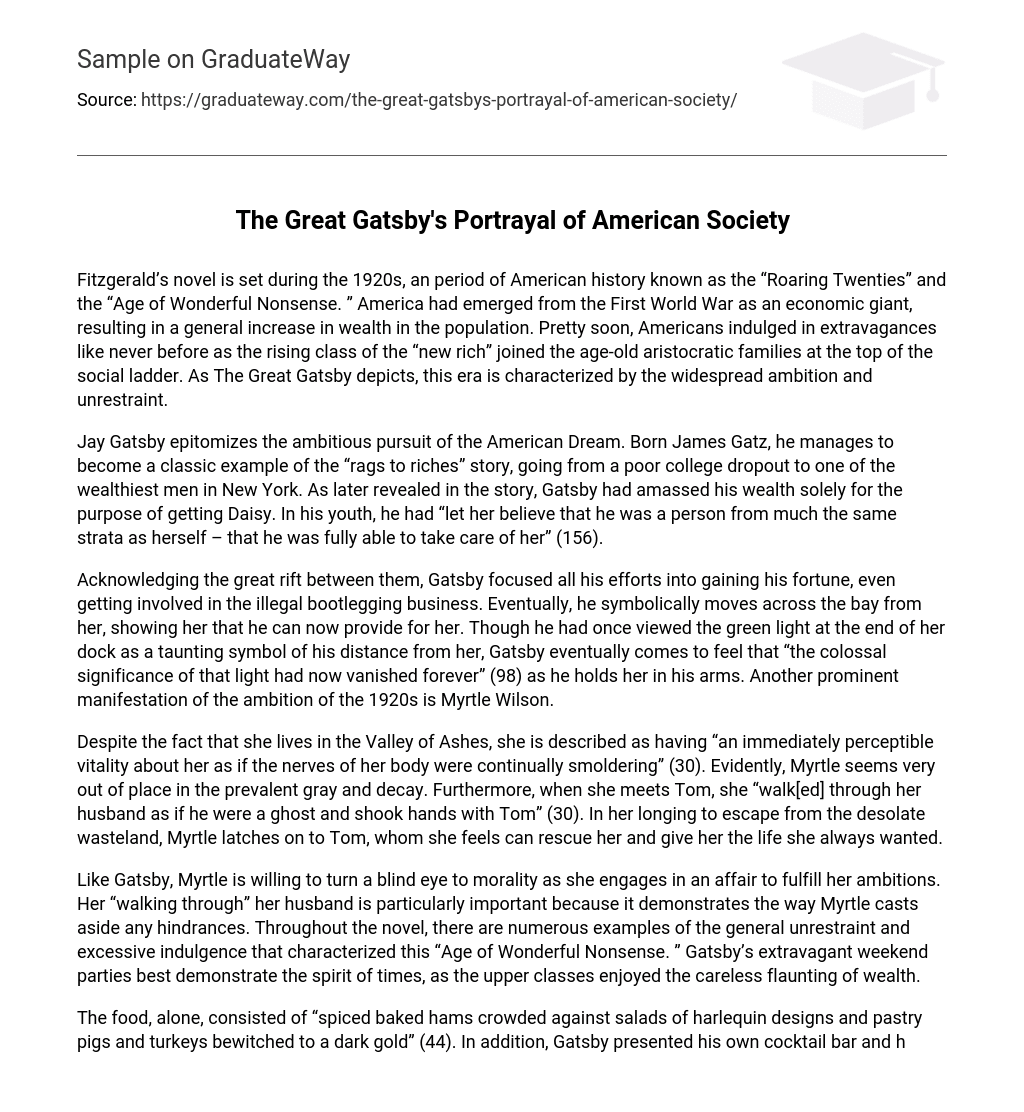Fitzgerald’s novel is set during the 1920s, an period of American history known as the “Roaring Twenties” and the “Age of Wonderful Nonsense. ” America had emerged from the First World War as an economic giant, resulting in a general increase in wealth in the population. Pretty soon, Americans indulged in extravagances like never before as the rising class of the “new rich” joined the age-old aristocratic families at the top of the social ladder. As The Great Gatsby depicts, this era is characterized by the widespread ambition and unrestraint.
Jay Gatsby epitomizes the ambitious pursuit of the American Dream. Born James Gatz, he manages to become a classic example of the “rags to riches” story, going from a poor college dropout to one of the wealthiest men in New York. As later revealed in the story, Gatsby had amassed his wealth solely for the purpose of getting Daisy. In his youth, he had “let her believe that he was a person from much the same strata as herself – that he was fully able to take care of her” (156).
Acknowledging the great rift between them, Gatsby focused all his efforts into gaining his fortune, even getting involved in the illegal bootlegging business. Eventually, he symbolically moves across the bay from her, showing her that he can now provide for her. Though he had once viewed the green light at the end of her dock as a taunting symbol of his distance from her, Gatsby eventually comes to feel that “the colossal significance of that light had now vanished forever” (98) as he holds her in his arms. Another prominent manifestation of the ambition of the 1920s is Myrtle Wilson.
Despite the fact that she lives in the Valley of Ashes, she is described as having “an immediately perceptible vitality about her as if the nerves of her body were continually smoldering” (30). Evidently, Myrtle seems very out of place in the prevalent gray and decay. Furthermore, when she meets Tom, she “walk[ed] through her husband as if he were a ghost and shook hands with Tom” (30). In her longing to escape from the desolate wasteland, Myrtle latches on to Tom, whom she feels can rescue her and give her the life she always wanted.
Like Gatsby, Myrtle is willing to turn a blind eye to morality as she engages in an affair to fulfill her ambitions. Her “walking through” her husband is particularly important because it demonstrates the way Myrtle casts aside any hindrances. Throughout the novel, there are numerous examples of the general unrestraint and excessive indulgence that characterized this “Age of Wonderful Nonsense. ” Gatsby’s extravagant weekend parties best demonstrate the spirit of times, as the upper classes enjoyed the careless flaunting of wealth.
The food, alone, consisted of “spiced baked hams crowded against salads of harlequin designs and pastry pigs and turkeys bewitched to a dark gold” (44). In addition, Gatsby presented his own cocktail bar and hired a full orchestra. Clearly, the surplus of wealth gave Americans good reason to indulge in materialism. The Great Gatsby’s portrayal of American society during the 1920s points out the prevalent ambitious pursuits and unrestrained indulgence of the time. Naturally, such traits led to the general decay of morality and social values as America became consumed by materialism.





